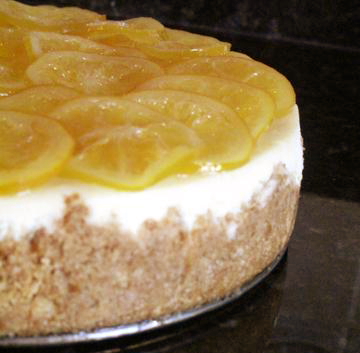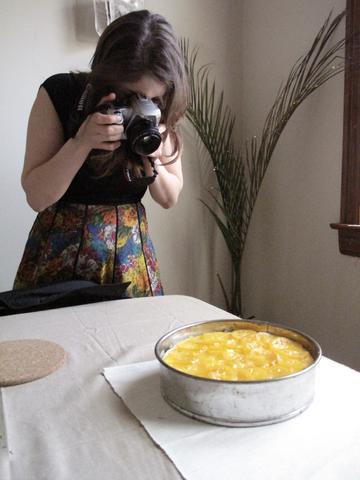 My in-laws are serious eaters. At all the gatherings I’ve attended, the quantities of food would make the Two Fat Ladies blush, and we always come home with several containers of leftovers. This Christmas was no exception! My mother in law hosted Christmas Eve, as is getting to be the tradition. She veered away from the usual Puerto Rican fare this year (roast pork, arroz con gandules) and went Mexican, making posole, ceviche and nopales (cactus) salad. One of his cousins brought an interesting new (to me) PR dish of chicken gizzards cooked with green bananas and a few green olives (something like this except it was served warm instead of like a salad). The dish is an unglamorous greyish color, but the flavor was great and the gizzards were much more tender than when I’ve made them. It re-inspired me to try making gizzards again after an unsuccessful attempt last summer.
My in-laws are serious eaters. At all the gatherings I’ve attended, the quantities of food would make the Two Fat Ladies blush, and we always come home with several containers of leftovers. This Christmas was no exception! My mother in law hosted Christmas Eve, as is getting to be the tradition. She veered away from the usual Puerto Rican fare this year (roast pork, arroz con gandules) and went Mexican, making posole, ceviche and nopales (cactus) salad. One of his cousins brought an interesting new (to me) PR dish of chicken gizzards cooked with green bananas and a few green olives (something like this except it was served warm instead of like a salad). The dish is an unglamorous greyish color, but the flavor was great and the gizzards were much more tender than when I’ve made them. It re-inspired me to try making gizzards again after an unsuccessful attempt last summer.
With all this great food in such abundance, it’s always hard to know what to bring. My MIL never wants to assign me a dish; she always demurs, saying that there will be enough food, or to just bring “whatever I want”. I know this is because she doesn’t want to impose, but I have somewhat mixed feelings about it… she knows I like to cook; I’m part of the family now; shouldn’t that warrant a side dish assignment? To be fair, for all I know she does the same with all the other relatives and they just bring whatever they feel like. But a small part of me would be flattered to be entrusted with something specific.
In the end, I just decided to make a dessert… you can never have too many, especially with his family’s sweet tooth! I didn’t feel like leaving the house for groceries, so I “shopped my pantry” and made a Meyer lemon pound cake with a lemon cream (lemon curd + whipped cream) to go on top. Although I’m not the biggest dessert/ cake person, I do love citrus (see these posts) and almost always have lemons in the house! I wasn’t sure if its simplicity would be appreciated, but to my delight it was almost gone by the end of the night, when richer and sweeter offerings remained.
 This recipe is from The Gourmet Cookbook, one I turn to often when I’m looking for a recipe that’s traditional yet updated. The method is simple, and you can certainly serve the cake as-is with the lemon glaze rather than making the lemon cream (although you need to zest all those lemons anyway, so you may as well use them). I did an easy curd where you mix everything and cook it together rather than tempering the eggs; it seemed to work about the same. You’ll want to strain it for textural reasons, but that’s about the fussiest part of the recipe. And I know a heavy cake recipe is probably the last thing you’re looking for right now, but you never know when you might decide to have people over for tea, or when you might need an easy recipe for your next get-together with your in-laws.
This recipe is from The Gourmet Cookbook, one I turn to often when I’m looking for a recipe that’s traditional yet updated. The method is simple, and you can certainly serve the cake as-is with the lemon glaze rather than making the lemon cream (although you need to zest all those lemons anyway, so you may as well use them). I did an easy curd where you mix everything and cook it together rather than tempering the eggs; it seemed to work about the same. You’ll want to strain it for textural reasons, but that’s about the fussiest part of the recipe. And I know a heavy cake recipe is probably the last thing you’re looking for right now, but you never know when you might decide to have people over for tea, or when you might need an easy recipe for your next get-together with your in-laws.
(Meyer) lemon pound cake (adapted from The Gourmet Cookbook by Ruth Reichl)
printer-friendly version
I made this cake with fragrant Meyer lemons, but regular lemons will do just fine. However, you will likely need more lemons for the curd if you don’t use Meyers, which tend to be much juicier.
for the cake:
2 cups cake flour (not self-rising)
1 tsp baking powder
¼ tsp salt
zest of 5 lemons (about ¼ cup)
2 sticks (½ lb) unsalted butter, softened
2 cups sugar
6 large eggs
1 ½ teaspoons vanilla extract
¼ cup fresh lemon juice
¼ cup whole milkfor the glaze:
1 cup plus 1 Tbs powdered sugar
2 Tbs fresh lemon juiceLightly grease and flour a 2-quart kugelhopf pan or bundt pan (a neutral-flavored cooking spray works well to get in the nooks & crannies). Knock out excess flour. Place a rack in the center of the oven and preheat oven to 325°.
In a medium bowl, whisk together the dry ingredients and zest. Cream the butter and sugar in a stand mixer or with an electric mixer until pale and fluffy, 2-3 minutes. Add eggs one at a time, beating well after each addition; then add vanilla. Reduce mix speed to low and beat in ⅓ of the flour, the milk, another ⅓ of the flour, the lemon juice, and the remaining flour, beating until just combined and scraping the sides of the bowl as needed. Pour the batter into the prepared pan (place on a baking sheet for easier transport in and out of the oven) and bake until top is browned and a skewer or knife inserted into the center comes out clean (original recipe specified 45-55 minutes but mine took about an hour and 10 minutes). Meanwhile, make glaze by combining powdered sugar and lemon juice until sugar is fully dissolved.
Cool cake in the pan for 15 minutes (see photo- a wine bottle works well for this). Invert on a rack and allow to cool completely before glazing. Put cake on a serving plate and pour glaze over top, allowing it to drip down the sides. If storing for later use, allow glaze to set before covering. This cake keeps well for several days if wrapped and refrigerated; allow to come to room temperature before serving.
Lemon Curd/ Lemon Cream (adapted from Baking: From My Home to Yours by Dorie Greenspan)
printer-friendly versionNote: in Dorie’s book, she uses the term “lemon cream” to refer to a variation on lemon curd containing a higher ratio of butter.
1 ¼ cups sugar
1 egg
6 egg yolks
6 Tbs butter, cut into 6 pieces
freshly squeezed juice of 4 lemons (use 5 or even 6 if lemons are dry)
optional: 1 pint heavy whipping creamWhisk together all ingredients in a medium heavy saucepan. Place over medium low heat and cook, stirring vigorously and constantly, until butter melts and mixture starts to thicken (original recipe says 4-6 minutes but I’ve never had mine cook that fast). The curd is done when you can make a track with your finger on a spoon or spatula and the curd doesn’t run into the track. It will look thin, but thicken as it cools. If desired, for a smoother texture, strain curd while still warm through a fine mesh strainer into a bowl. Press plastic wrap over the top so a skin doesn’t form, and cool in the refrigerator.
To make lemon cream, whip cream with beaters or a stand mixer until it has body, but before it becomes firm. When curd has fully cooled, stir in whipped cream to taste- less for a more pronounced lemon flavor and more for a milder, creamier flavor.

















 I had gotten the idea for candied lemons because a few weeks ago there were Meyer lemons all over the grocery stores and I wanted to take advantage of the season (go
I had gotten the idea for candied lemons because a few weeks ago there were Meyer lemons all over the grocery stores and I wanted to take advantage of the season (go  The recipe itself was pretty darn easy, mainly just combining ingredients in a bowl and dumping them in the pan. And fortunately I didn’t have any issues with waterlogged crust or a crack in the top. I thought this was a good albeit very rich recipe. There was no flour (is there usually flour in cheesecake? I have no idea. I thought maybe there was a little), so the consistency was very soft and not at all “cake-y”, and it got kind of melty at room temperature, but was much better chilled. The consistency may have changed a little due to my adaptation as well. To flavor the cheesecake, I substituted 1/4 cup marmalade for 1/4 cup of the sugar, added the Microplaned zest of one lemon, and substituted lemon juice for the liqueur (too bad I didn’t have any Limoncello on hand!). You’d think it would have turned out ultra-lemony, but it was actually pretty subtle. The candied lemons on top were what really gave it some kick; I liked how their slightly bitter bite offset the sweetness and richness.
The recipe itself was pretty darn easy, mainly just combining ingredients in a bowl and dumping them in the pan. And fortunately I didn’t have any issues with waterlogged crust or a crack in the top. I thought this was a good albeit very rich recipe. There was no flour (is there usually flour in cheesecake? I have no idea. I thought maybe there was a little), so the consistency was very soft and not at all “cake-y”, and it got kind of melty at room temperature, but was much better chilled. The consistency may have changed a little due to my adaptation as well. To flavor the cheesecake, I substituted 1/4 cup marmalade for 1/4 cup of the sugar, added the Microplaned zest of one lemon, and substituted lemon juice for the liqueur (too bad I didn’t have any Limoncello on hand!). You’d think it would have turned out ultra-lemony, but it was actually pretty subtle. The candied lemons on top were what really gave it some kick; I liked how their slightly bitter bite offset the sweetness and richness.




 Here’s an informative
Here’s an informative 



 3 cups freshly squeezed blood orange juice, or a combination of freshly squeezed orange and blood orange juices
3 cups freshly squeezed blood orange juice, or a combination of freshly squeezed orange and blood orange juices